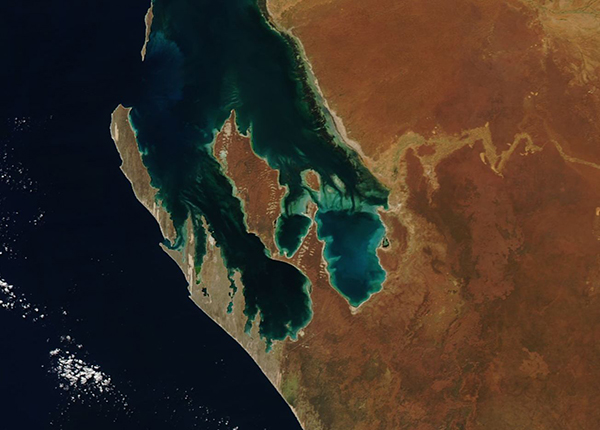Images
July 13, 2018 - Shark Bay Australia
Tweet
Swirls of bright blue in the waters of Shark Bay, Australia point to the presence of phytoplankton in the bay. These plant-like microscopic organisms exist in the waters year-round, but reproduce in large numbers in when nutrients, daylight length, and water temperatures are favorable. At such times, the blooms become so large that they can easily be seen from space.
Like terrestrial plants, phytoplankton play an important role in the carbon cycle by using photosynthesis to consume carbon dioxide and release oxygen. In addition, carbon can be sequestered in the ocean bottoms as the organisms dies. Phytoplankton also form the base of the marine food web, feeding everything from the microscopic, animal-like zooplankton to multi-ton whales. Smaller fish and invertebrates also graze on phytoplankton and those organisms in turn feed other fish, mammals, birds – and even humans.
Shark Bay has been designated as a UNESCO World Heritage Site notable for its luxuriant beds of sea-grass, for providing a home to the dugong (sea cow), and for its rich biodiversity. Not only does phytoplankton exist in these waters, but so does another plant-like feature: stromatolites. These are large colonies of algae which form hard, dome-shaped deposits. According to the UNESCO description, these stromatolites are among the oldest forms of life on Earth. Shark Bay is also home to five endangered species of mammals.
The Moderate Resolution Imaging Spectroradiometer (MODIS) aboard NASA’s Aqua satellite acquired this true-color image of Shark Bay, Australia on July 10, 2018.
Image Facts
Satellite:
Aqua
Date Acquired: 7/10/2018
Resolutions:
1km (79.8 KB), 500m (176.2 KB), 250m (109.7 KB)
Bands Used: 1,4,3
Image Credit:
Jeff Schmaltz, MODIS Land Rapid Response Team, NASA GSFC
Tweet
Swirls of bright blue in the waters of Shark Bay, Australia point to the presence of phytoplankton in the bay. These plant-like microscopic organisms exist in the waters year-round, but reproduce in large numbers in when nutrients, daylight length, and water temperatures are favorable. At such times, the blooms become so large that they can easily be seen from space.
Like terrestrial plants, phytoplankton play an important role in the carbon cycle by using photosynthesis to consume carbon dioxide and release oxygen. In addition, carbon can be sequestered in the ocean bottoms as the organisms dies. Phytoplankton also form the base of the marine food web, feeding everything from the microscopic, animal-like zooplankton to multi-ton whales. Smaller fish and invertebrates also graze on phytoplankton and those organisms in turn feed other fish, mammals, birds – and even humans.
Shark Bay has been designated as a UNESCO World Heritage Site notable for its luxuriant beds of sea-grass, for providing a home to the dugong (sea cow), and for its rich biodiversity. Not only does phytoplankton exist in these waters, but so does another plant-like feature: stromatolites. These are large colonies of algae which form hard, dome-shaped deposits. According to the UNESCO description, these stromatolites are among the oldest forms of life on Earth. Shark Bay is also home to five endangered species of mammals.
The Moderate Resolution Imaging Spectroradiometer (MODIS) aboard NASA’s Aqua satellite acquired this true-color image of Shark Bay, Australia on July 10, 2018.
Image Facts
Satellite:
Aqua
Date Acquired: 7/10/2018
Resolutions:
1km (79.8 KB), 500m (176.2 KB), 250m (109.7 KB)
Bands Used: 1,4,3
Image Credit:
Jeff Schmaltz, MODIS Land Rapid Response Team, NASA GSFC




